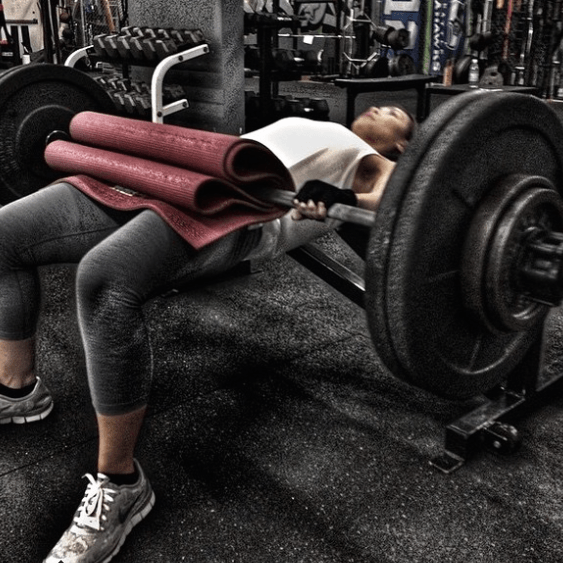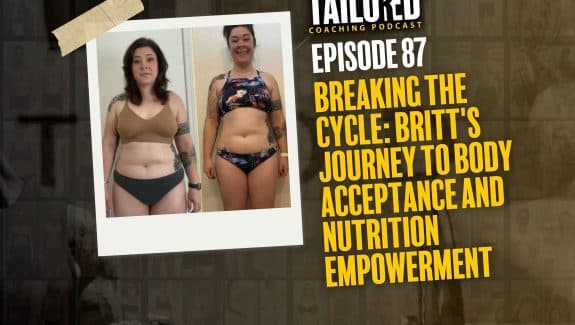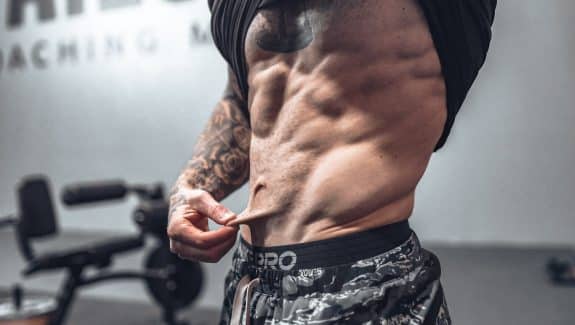When I decided to write this article, my first thought was actually just being surprised that I hadn’t written it already… And now, it’s just being happy that I’ve decided to come back at it, add more content and improve it all.
Lot’s of people know that many of my clients refer to my team as “#TeamBoomBoomBooty” and I’m getting pretty well known for the glute work as I grow in this industry, which is awesome.
And to be honest, I’m just an ass guy.
But I mean that in more ways than just what I’m attracted to! I mean yes, I like big butts and I cannot lie….
But I also know that developing great glutes can help get rid of nagging low back pain, help us with postural issues, create much more force and power in many other leg dominant lifts, help you generate more speed while sprinting and more power when jumping, and last but not least…
Everyone looks better with a nice ass, even guys! Ask ANY female; they NEVER want a dude with a flat butt. [You’re welcome guys…]
So now that I’ve hopefully talked you into why having great glutes is important, let me break down exactly how you can do that in 3 steps.
The first step in achieving a better butt isn’t sexy, cool, or fun, to be completely honest. But it is one of the most crucial steps, without a doubt.
#1 – Posture and Activation
This is the one people most often miss and always the first thing I address when someone is struggling with getting there glutes to grow or to even activate in general.
[This is exactly what my issue was as well, but once I fixed it my glutes grew like weeds… In fact, for my own personal testimony – When I programmed the following into my training for 12-weeks (the summer season), my glutes grew to a point I had to return my jeans to Nordstroms once fall came. It was funny telling the lady in the men’s department that my ass was too big for the jeans now… Click HERE to start the program I was on]
Many people have what’s called an “Anterior Pelvic Tilt” or as I like to call it, “Duck Butt”.
This is simply where your low back arches, creating that curvature above the glutes. It can sometimes look like someone is just sticking their ass out, when it’s actually a postural issue.
Here’s an example:
[Picture by – http://darwinian-medicine.com/master-the-deadlift/]
This may be a slightly exaggerated image, but 75% or more of people who come to me suffer from this so it’s important for us to cover. The main issue here is that when you have an anterior pelvic tilt, your glutes can’t fire properly and if there is no activation there is no growth, period.
Other symptoms that usually associate with this positioning of the hip is weak core strength, tight hip flexors, low back pain, and of course weak glutes.
This can even be an issue with your other lifts as well, like the lunge for example. Ever notice it’s hard to stay tall while performing the lunge? Or your hip shoots back as soon as you try to stand back up? Could be a glute activation issue, which could be stemming form an anterior pelvic tilt. But that’s a topic for another day, back to the booty.
The main reason you cannot build great glutes with this anterior tilt issue is because your glutes cannot activate properly until your hips can drive forward optimally, in the right postural position. To fix this issue and get them working properly, you’ll need to work on a few things.
1.) Hip Mobility and Positioning (Using things like dead bugs and PRI breathing drills will help significantly here. Click HERE for examples).
2.) Learning To “Pull Your Rib Cage Down” (This is more than just “Flexing” your abs, it is imagining you’re pulling the top of your ribcage down to your waistline and compressing)
3.) Stretching Your Hip Flexors
4.) “Pre-Fatiguing” Your Glutes (This is the last piece as it can help a lot, but #’s 1-3 are needed first – Pre-Fatiguing is simply training the glutes with lighter weight and focusing on tension, prior to training the big lifts for that day).
Simply focusing on tilting your hip the opposing way of an anterior tilt at the top of each rep can help tremendously as well. You may even feel hunched over at first because it is an awkward and uncomfortable posture for you to be in, because you’ve lived in extension and anterior tilt for so long already.
But different is better and in this case leads to a bigger, and much nicer, butt.
So, one more time, the conclusion of this step comes down to hip mobility, learning to pull your rib cage down and bracing your core, releasing the tension in your hip flexors, tilting your hip the opposite way of the anterior tilt, and finally pre-fatiguing the glutes before lifting.
# 2 – Exercise Selection
This is one that always seems to surprise people when I talk to them about which exercises to do.
I always hear talk and see people posting on social media’s about squatting for a great ass… Squats are without a doubt a staple in my programming and can help us here, but they’re not the major key to a great ass.
This issue with this is that to activate the glutes significantly through a squat, we need to either squat pretty deep, as in below parallel, or be a glute dominant squatter. Glute dominant squatters are usually people with long femurs, this forces them to sit back more into it and stretches the glute. This will get the glutes more engaged in the lift, making them more of a glute dominant squatter.
Or you’re like me, someone who is a quad dominant squatter and for me to really hit my glutes in the squat I need to squat deep.
Now this is achievable, but with adequate weight it can be pretty damn difficult without destroying your back, especially if you have an anterior pelvic tilt. That is why I typically program front squats or just plan to squat towards the end or middle of my training at a lighter weight and higher rep count, with the exception of my clients who can squat really well.
All that being said, lets break down the #1 Butt Building Exercise… The Hip Thrust.
This isolates the glutes, helps you enforce fixing an anterior pelvic tilt, it’s safer on your back, and you can do a lot of volume without overloading the spine or causing too much risk of injury.
I will use this as a pre-fatigue exercise before my client’s bigger lifts or as an assistant exercise later on in the session; the great thing is its diversity and ability to hit the glutes so optimally. If you’ve ever done these, you know exactly what I’m talking about.
Now this isn’t the only exercise you can use and is definitely not the only one I use, but when thinking of exercise selection I break things down into three categories.
1.) Pre-Fatigue
-Hip Thrusts
-Glute Bridges
-Resisted Hip Abductions
-Resisted Kick Backs
-Fire Hydrants
2.) Strength Lifts
-Deadlift Variations (This is my #1 choice for sure)
-Squat Variations
3.) Assistant Exercises
-Bulgarian Split Squats
-Goblet Squats
-KB Swings
-Front Squats
-KB Swings
-Lunge Variations
-Glute Bridges
-Hip Thrusts
-Glute Ham Raises
-Sprints
[For Demo’s on these and other great exercises, check out my YouTube Channel]
These can all be implemented to achieve great glutes but we need to remember a few things when we determine what will go into our program…
Firstly, the amount of pre-fatiguing we do on the glutes needs to be tailored to the specific individual. If you’re goal is athletic performance or strength, I wouldn’t emphasize it as much – although I would if you suffer from a weak core or glutes, an anterior tilt, or any low back issues because we still want the glutes working optimally when lifting, but not fatigued as growth is not the main goal and it can hinder strength if overdone.
Secondly, you don’t need to do them all every single training session. My suggest is to perform strength training 3-4 times per week and utilize one thrust or bridge variation in each session, one squat or deadlift variation in each session, and one single leg movement in each session. If you end up adding another one in there, it can definitely help with the growth but we want to make sure we’re progressing moderately as we cannot add reps or weight forever…
[Click HERE for my FREE Guide to Progressing Your Training Properly]
Lastly, volume equals growth. So determining the volume and frequency of your training is a Major Key for great results.
#3 – Volume = Growth
This concept is simple, volume is one of the biggest keys when trying to build size and most people miss this when training glutes directly. Yes they train their legs more than once a week and that is also a necessary step towards a better butt.
But we need to increase the volume of direct glute isolated training, things like hip abductions, swings, hip thrusts, etc.
Not much more for me to say other than, “Train them more!”
When growing your glutes is the goal, I suggest performing a glute dominant pre-fatigue style exercise like band-resisted hip abductions followed by a hip thrust or glute bridge variation prior to your big lifts.
For example, the beginning of your strength training programs may look something like this:
1.) Band Resisted Sprint – 4×15/45 or Jump Squats – 4×6 [Being Explosive is KEY for Results]
2.) Hip Abductions – 2-3×15-25 [Get the glutes firing]
3.) BB Hip Thrust w/ Pause – 2-3×8-20 [Then hit the big glute exercise]
I gave broad rep and set range here for the simple fact that we need to change these up during each session, something referred to as DUP (Daily Undulated Periodization). Many people do this with the big lifts like Bench, Squat, and Deadlift, and they achieve great strength and muscle gains from doing so. So when we apply it to hip thrusts, the same thing happens.
Day 1 may be 3×6-8 with 2 sec pauses at contraction, day 2 may be 3×12, and day 3 may be 2×20-25.
With this set up we hit each rep, set, and intensity scheme possible within the week, which has been shown to increase the size of a muscle extremely well.
In fact, Brad Schoenfeld even did a study to prove this. He took two groups of men, both doing the same exercise, same sets, same sets, and same intensity levels. The only thing that differed was the frequency. One group did “Leg Day” essentially and trained the muscles once per week, similar to the common bro split. The other group did DUP and hit the muscle multiple times per week, 3 to be exact.
The result? The higher frequency, DUP model, group had more significant gains.
We believe this is true because resistance training stimulates an anabolic signal in our body’s and also stimulates muscle protein synthesis, both big factors in muscle growth.
Think of it like bouncing a balloon. We can punch the balloon up really high and get a great distance (or response) from that, but it’s still going to fall back down to the floor shortly after.
Where as if we lightly tap it up, keeping it constantly afloat, it will drop down again too but we also bounce it back up more frequently.
Well in training, if we use this principle, we can keep the muscle protein synthesis and anabolic rate up more frequently. Instead of hitting it hard one time and smashing our body, so we cannot train again for a week – we hit it enough to stimulate the needed response but not too much, so we can train it again a day or two later.
Regardless of how hard we hit it one day, muscle protein synthesis will only rise up so high – but if we destroy ourselves one day, we physically are too sore to train again and take advantage of this frequency principle.
Now, I could easily go into much more detail in each of these steps and when working with a client I do by having more variations, more tempos, more ways of incorporating volume, and sometimes need to do more specific things to get people activating and building efficiently depending on the individual.
This is the way I’ve built “Boom-Boom Booty’s” with hundreds of clients looking to achieve this goal and if you take this, use it in your training, and stay consistent with it I can guarantee you will build some great glutes.
But because of popular demand with this goal, from men as well as women, I decided to launch a 12-Week Online Transformation Program leading into this summer to not only help you build a better butt, but also build lean muscle head to toe and lose that unwanted body fat.
I currently have 12 spots open for this Online Coaching Transformation Program, and inside you’ll get:
-
Individualized Training Program
-
Individualized Nutrition Coaching [Coaching, NOT a meal plan. This is tailored to you, your goals, your lifestyle, and fits in the foods YOU enjoy]
-
24-7 Access to me for help, support, questions, adjustments, and more.
-
Accountability and Support from me to ensure you’re staying on track.
-
Weekly Updates and Adjustments to ensure consistent Progress
This program is for ANYONE trying to lose unwanted body fat, build lean muscle tissue, transform their body within 12 weeks, and of course… build a better butt.
Click HERE to apply now.


























































































































































































































































































































































































































































































